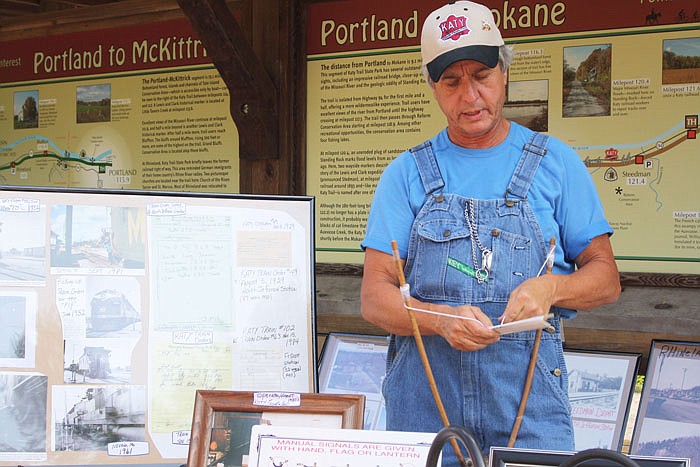PORTLAND, Mo. - On Sunday, members of the Kingdom of Callaway Historical Society took an educational trip to Portland, Missouri, inviting members of the public to accompany them. Tuesday's coverage followed the winding road down to the small community, paused in a courtroom for a historical murder trial and wrapped up in a memorabilia-packed home overlooking the Missouri River.
Today, drop by a church that's an identical quadruplet and learn about Portland's rich history as a railroad and river town from those who remember it.
St. Mark's Episcopal Church
The next stop after Bob and Jodi Plummer's house was the local church, active since 1910. It's named for the school; originally, the congregation had met in the school's chapel, until the school closed and they persuaded the bishop to build a church.
According to Rev. Marshall Crossnoe, part-time vicar at the church and history professor at Lincoln University, St. Mark's was one of four Missouri churches built with the exact same floor plan. The others stood in Bonne Terre, Fulton and Salem; Bonne Terre's is the only other one still standing.
While at first glance, the church appears to be built of stone, a closer look reveals the blocks are actually concerete.
"It was cutting-edge technology," Crossnoe said. "'Let's build some cement blocks that look like stones.'"
The material was taken up the river by boat from St. Louis.
Today, the average Sunday at St. Mark's draws nine worshippers, some of whom are third-generation attendees. Crossnoe was proud to report in the previous year, they had baptized two children. The church also has traditionally held a joint Thanksgiving service with the Baptist and Methodist churches in town.
"There's no reason for so few of us to be fighting amongst ourselves," Crossnoe said, quoting Bob Plummer.
Katy Railroad
Mike Offineer set up a display with pictures of the old Katy Railroad and other railroad memorabilia down beside the Katy Trail, which runs along the railroad's former route in Missouri.
Offineer worked for the Katy Railroad for 15 years, starting as a brakeman and working his way up to the position of railroad engineer. The MKT Railroad Company, which operated the line, merged with Missouri Pacific Railroad in 1988, and Offineer road on the very last train from Franklin to St. Louis - right through Portland - on April 11, 1986.
By his retirement in 2014, he'd been riding the rails for 41 years.
"Either it gets in your blood or it don't get in your blood, and it got in my blood," he said.
Offineer began learning and collecting the history of railroads early in his career.
"It's one of the ways I can stay connected with the railroad," he said.
Between when he first climbed aboard in 1973 and his last ride, he saw the industry evolve significantly.
Take, for example, the death of the caboose.
Cabooses served several purposes. They gave the crew somewhere to shelter, provided a mobile office for the conductor to do paperwork and allowed the crew to look out over the train and spot issues like hot boxes. Hot boxes were overheated axle bearings, which often caught on fire.
Conductors were assigned a caboose of their own, which would get transferred from train to train with them. Sometimes, they'd take their caboose with them when they retired.
Today, a train's crew consists of just an engineer and a conductor, who ride in the locomotive. Instead of the crew's eyes, sensors built into the line "watch" for hot boxes.
And where the caboose would be, there's an "end of train device," loaded with sensors that measure air pressure, whether the entire train is in motion after it gets started and more.
"Technology has pretty much taken the place of the caboose," Offineer lamented. Cabooses faded out in the 1980s, and few exist today.
Riverboat replicas
The tour's last stop was the back porch of Holzhauser's Bar and Grill, where Portland resident Larry Languell lined up his scale models of several riverboats.
"I build 'em all on the water," he said. They're equipped with electric motors and are capable of a (short) voyage on the river.
He displayed a 4-foot model of The Mitchell, which was once captained by a Portland resident, along with three others.
"I have 11 or 12 of them at home," Languell said, admitting he'd lost count. He started building boats about 20 years ago, working on them during winters.
Many of the boats he's chosen to build are related to local history.
"I was raised on the river bank up in Cote Sans Dessein (Missouri)," he said. "I knew some of the guys on The Mitchell."
The John L. Ferguson, which he also had out on display, was named for a resident of nearby Tebbetts, Missouri.
Languell carves and builds every component of the boats himself - no kits at all. The little human figures populating the decks are often repurposed toy soldiers. He cuts off the guns, heats the figures using an acetelyn torch, poses them the way he wants and paints them.
On the top deck of the Arabia, Languell perched a Tebbetts local playing a tiny violin he whittled himself.
Inside Holzhauser's, tour participants rested their feet and enjoyed brews and burgers before heading back home.
"My favorite part was the boys school with all the beautiful antique furniture," Karen Brown said.
Brown is a historical society member and history fan who enjoys going to reenactments. Her adult daughter, Michelle Miller, accompanied her on the tour.
"I loved watching the reenactment and hearing all the little details," Miller said.
The "cruise" to Portland was such a hit - final ticket sales totalled 89 - Huddleston and the other historical society members are already brainstorming where to go next. Watch the event calendar at kchsoc.org for upcoming destinations and dates.

